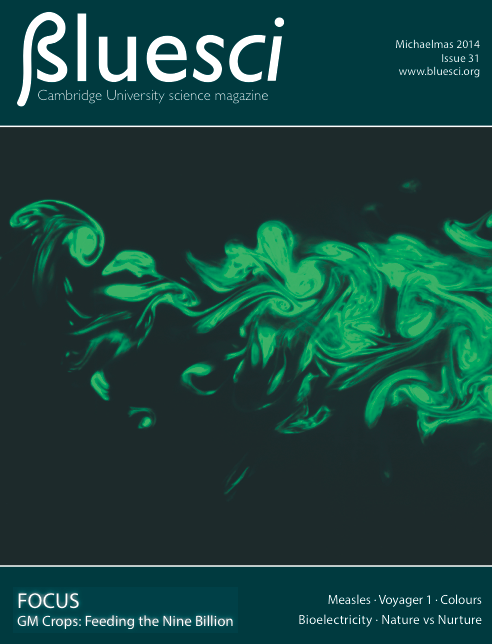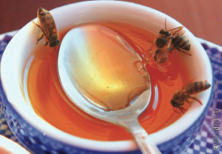SATURDAY, 11 OCTOBER 2014
Most of us experience turbulence through stomach-churning drops in an aircraft. Fortunately the turbulence that is widely researched by engineers and scientists is much less nauseating, yet remains an intimidating subject. Research on turbulence is related to the chaotic, swirling behaviour of fluids, which comprises both liquids and gases. We can find turbulence in many naturally-occurring and man-made flow scenarios, such as the mushroom clouds created by volcanoes and nuclear bombs, and the swirling flows in tornadoes and behind propellers. In fact, it is difficult to study most fluid phenomena without taking into account the effects of turbulence. Unfortunately, even after almost 175 years of research this chaotic fluid behaviour is not yet understood, illustrating the unforgiving complexity of this topic. However, the chaotic nature of turbulence is precisely what allows fluids to mix so well. Without turbulence, exhaust gases that are ejected from cars, aircraft, and smoke-stacks would simply not disperse effectively with the surrounding air.A simple explanation categorises fluids into two different states of flows, laminar or turbulent; which of these flow states a fluid adopts is dependent on both the viscosity and the inertia of the fluid. Viscosity, which can be described as the ‘stickiness’ of the fluid, can best be explained with an example: golden syrup is very viscous, whereas olive oil is much less viscous. Try stirring a bowl of golden syrup and you will notice that it does not
mix very easily. This is because its viscosity is restricting the mixing motion. The inertia of a fluid describes its resistance to changes in motion. For example, the fast- moving exhaust gases leaving the nozzle of a rocket have
a lot of inertia. Laminar flows are steady and predictable because they are stabilised by viscosity, which is relatively strong compared to the inertia of the fluid. Fluids become turbulent when the effects of viscosity become very small compared with the inertia of the fluid motion. This is
the result of having a fluid with less viscosity (e.g. oil) or mixing the fluid very quickly to increase the inertia (e.g. mixing golden syrup with a blender).
The image on the cover of this issue of BlueSci shows a group of cultured mouse embryos that have developed until the blastocyst stage, just before implantation into the uterine wall. It was taken by Mubeen Goolam in Professor Zernicka-Goetz’s lab in The Gurdon Institute at the University of Cambridge. The embryos were stained with fluorescent markers capable of binding different cell-type specific proteins which, in turn, allows the identification of different cell lineages present in the blastocyst. The blue cells are the trophectoderm, the white cells are the epiblast, and the pink cells are the primitive endoderm. The image also shows that a number of the blastocysts appear to have ‘burst’ and have regions where the cells are ‘spilling out’ of their original boundary. This is expected and is not an artefact of the staining procedure. These blastocysts are ready to implant into the uterine wall and thus have burst out of their membranous boundary. This is evidence that they have developed perfectly while in culture.
An interesting feature of turbulence is the prevalence of swirling motions. Move a teaspoon in a straight line through a cup of tea and you will notice swirling patterns in the wake behind the spoon. This is the effect of ‘shear’ on fluids, and shearing motion is unstable. In laminar flows, the viscosity inhibits the unstable, shearing motion, but in turbulence this motion is allowed to roll- up the fluid into the swirling patterns that we observe. This explains the shape of the mushroom clouds from volcanoes and nuclear explosions. The sudden upwards movement of air from the volcano or explosion is being dragged, or sheared, against the relatively motionless surrounding atmosphere whilst the inner fluid of the cloud moves at greater speed. This shearing motion of slow movement on the outside of the cloud and fast movement on the inside results in the cloud of fluid rolling up into a turbulent mushroom shape.
Turbulence exists over a range of scales, which means that there are very large, random, swirling motions, and within them are moderately-sized swirling motions, and within those even smaller ones, like a set of Russian dolls. While it might seem easy to dismiss the smallest motions in turbulence, these motions are in fact responsible for many important features in turbulent flows such as the mixing between exhaust gases and the air, and the skin- friction drag from the airflow over cars and aircraft. The motivation behind a lot of turbulence research is therefore directed towards understanding small-scale turbulence, which is very difficult to predict, in relation to the larger scales of the flow, which are easier to predict.
The image on the front cover of Issue 31 illustrates the remnants of turbulent flow structures following an experiment. The aim of this experiment was to investigate the behaviour of turbulence at a small scale, in the order of a few millimetres. The turbulence was generated by injecting a jet of dyed water into a tank of still water (think of spraying a water pistol that is submerged in a bathtub). The bright green patterns are visualised using a fluorescent dye and a powerful laser. The laser beam is formed into a thin sheet of light, which means the cover image represents a two-dimensional slice through the fluid. Note the mushroom-shaped patterns that are similar to that from a volcanic eruption. These patterns were caused by some of the dyed fluid being pushed outwards into the still, ambient region. The difference in the fluid speed between the slow outer region and the fast inner region of the dyed fluid resulted in shear-produced swirling motions in the shape of mushrooms. In this regard, the scalable nature of turbulence means that we are able to study large, natural phenomena in a laboratory setting. Researchers ultimately hope to find some coherence in this chaos to help explain the intricate and entrancing patterns that turbulence produces.
Dhiren Mistry is a 3rd year PhD student in the Department of Engineering
Dhiren’s image was shortlisted in the University of Cambridge’s Department of Engineering Photography Competition 2013. The competition, sponsored by Zeiss, aimed to show that engineering is not only about fixing machines and building bridges, but involves everything from studying objects and processes in microscopic detail, to building towering structures.


